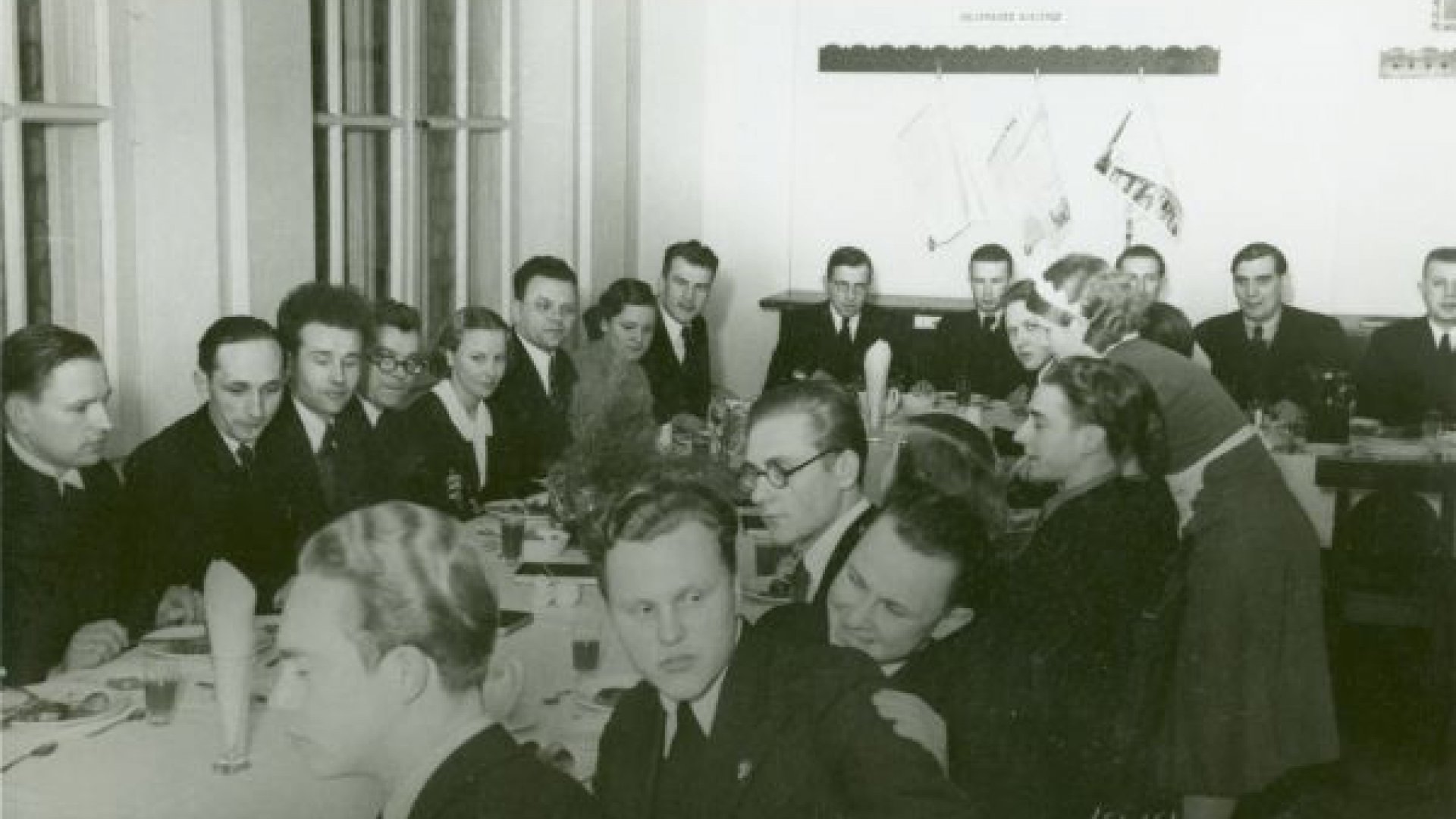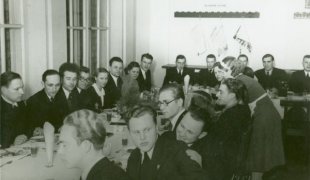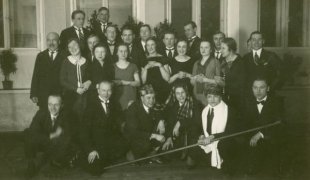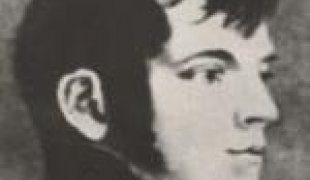About the History of Theology in Estonia
Theology and theology teaching until the end of the 18th century
As in mediaeval Europe in general, theological instruction, and apparently some kind of research, in Old Livonia took place in cathedral and monastic schools. Libraries were also in monastic ownership. Mauritius, a student of Albertus Magnus, acted as head of school at a Dominican monastery in Tallinn in the last quarter of the 13th century.
Already in 1236, the Supreme Chapter of the Dominican Order issued the injunction that the monks learn the local language. At minsters, sermons were preached in Estonian beginning from end of the 13th century. Since 1428, the Riga Provincial Synod required that sermons at rural churches be also preached in the local language. That same year, a Latin school was founded on top of the monastic and cathedral schools. During the Reformation, the Latin school was reformed into a trivial school in 1528. Elementary schools were established in Tartu, Narva and Paide while cathedral schools continued in Tallinn, Tartu and Haapsalu. Attempts were made to meet the need for religious instruction in the local language by publishing catechisms in Estonian (Wanradt-Koell’s in 1535, Witte’s in 1553-54); those, however, were banned by the town councils of Tallinn and Tartu, respectively. Jesuits opened a secondary school in Tartu in 1583, followed by a college, the first higher education establishment in Estonia, along with a seminary for translators in 1585. That same year saw the publishing by Jesuits of a Roman Catholic catechism in Estonian. The college also published other multilingual manuals of theology.
Under Swedish rule, the Lutheran church was elevated to the status of the state church. Three academic secondary schools were opened (in Tartu in 1630, in Riga and Tallinn in 1631). On the initiative of Governor-General Johan Skytte, the secondary school in Tartu was transformed into a university by ordinance of King Gustav II Adolph of 30 June 1632.
True to tradition, the Faculty of Theology became the leading faculty at the university. The educational work was modelled on the Faculty of Theology of Uppsala University, which dictated a four-stage professorship: Theologian I (professor in ordinary) teaching the Old Testament (OT) history books and church history; Theologian II (also professor in ordinary) teaching the New Testament (NT) books and church history; Theologian III (professor extraordinary) teaching the prophetic books; and Theologian IV (also professor extraordinary) teaching letters of the Creed and polemics. Practice was primarily conducted by the adjunct. The professors extraordinary of the Faculty of Theology were also engaged in teaching Hebrew, Greek or oriental languages at the Faculty of Philosophy. Actually, the position of Theologian IV was vacant during the periods of both Academia Gustaviana (1632-56) and Academia Gustavo-Carolina (1690-1710), when the respective educational duties were fulfilled by other lecturers. Similarly, the Faculty of Theology of Academia Gustavo-Carolina had no adjuncts employed, and the instruction given by Theologians I, II and III often diverged from their speciality. Instruction was conducted in the form of lectures, disputations and examinations. The scientific degrees awarded were those of the candidate, the licentiate and the doctor. To be awarded a scientific degree in theology, the applicant was required to have previously studied at the Faculty of Philosophy and graduated from it with at least a master’s degree, which was the first level there. Naturally, it was mandatory for students of theology to study Hebrew and Greek at the Faculty of Philosophy; mastery of Latin was taken for granted of a university entrant. To be awarded the theology candidate’s degree, the applicant was to take the respective examination and present a disputation. The licentiate’s degree involved doing an all-embracing examination, “totum theologici studii cursum” (of the University of Tartu lecturers, that was passed by Mancelius in 1632, Goetschenius in 1633 and Schomerus in 1639). The doctor’s decree required defending a dissertation (of Tartu lecturers, this was done by Gezelius in 1661 and Schomerus 1648, and of Pärnu lecturers, Moberg in 1699); since 1675, the award of the degree was to be approved by the King of Sweden. Pursuant to the University’s bylaws, the theological orientation of the University and its Faculty of Theology was to fit into the frame of the Lutheran orthodoxy. The rector was to take a vow that pure evangelical doctrine would be taught. A professor was to vow that he would remain till death a disciple of the true faith as expressed in the Scriptures, the Apostles’, Nicene and Athanasian creeds, would adhere to the unaltered Augsburg creed and avoid any heretical teachings. As a rule, the professors kept their vow, with the exception of Georg Preussius, who was for some time influenced by a form of religious syncretism then widespread in Sweden, which pursued the unification of the Roman Catholicism and the Protestant movements.
During those times, 18 lecturers were employed at the Faculty of Theology of the University of Tartu (UT). Throughout the Academia Gustaviana period, the position of Theologian I was occupied by Prof. Andreas Virginius (his years of service here and hereinafter 1632-56). The position of Theologian II at that institution was held by professors Georg Mancelius (1632-37), Petrus Schomerus (1639-40), Salomo Matthiae (1642-50) and Gabriel Elvering (1652-56), and that of Theologian III by professors extraordinary Johann Weideling (1632-33), Petrus Goetschenius (1633/34-36), Johann Gezelius (1643-49) and Georg Preussius (1654-56). The adjuncts were Adrian Virginius (1638-47) and Petrus Svenonis Lidenius (1652-56). During the Academia Gustavo-Carolina period, Theology I was taught by professors Olaus Moberg (1690-95 and 1698-1705), Crispin Jernfeld (1695) and Johannes Folcher (1707-10), and Theology II by professors Crispin Jernfeld (1690-95), Olaus Moberg (1695-98), Lars Molin (1698-1703), Johannes Folcher (1703-1707) and Ingemund Bröms (1707-09). The post of Theologian III saw the succession of professors Olaus Moberg (1690 as acting theologian), Lars Molin 1695-98), Gabriel Skragge (1698-1701), Johannes Folcher (1701-03), Ingemund Bröms (1705-07) and Nicolaus Wiraeus (1707-10). Thus, during its 30 years, Academia Gustavo-Carolina employed seven professors, who under difficult circumstances (plague and famine in Tartu in the 1690s and wartime in Pärnu from 1700 until 1710, the year the University was liquidated) made every effort to maintain the level of education, switching among themselves the professorships of Theologians I, II and III to ensure coverage of the disciplines. The faculty included some outstanding scholars. For instance, Andreas Virginius produced commentaries on the books of the Bible, and under his direction, many disputations were written, particularly on the exegesis of the Psalter and the gospels of Matthew and John; Georg Mancelius and Gabriel Elvering were experts in the histories of the Church and dogmatics, who focused on the apologists in their research and supervised numerous disputations; and Olaus Moberg was an authority on Christian morality and ethics. Theologians of the UT had scientific connections with the key Protestant Universities of Europe.
During the Tartu and Pärnu periods, the University’s printing shop played an important cultural role. The 1,389 publications known to be issued between 1632 and 1710 included 181 disputations or dissertations on theology; apart from these, scores of orations (thematic speeches resembling those delivered at an examination) of theological content were printed there. Printing shops were also established under the department of the Superintendent-General in Riga and the secondary school in Tallinn.
The importance of the then University, which operated in Tartu and Pärnu, to the cultural progress of Estonia is difficult to overestimate: suffice it to say that of the persons having studied, for a shorter or a longer term, at the University about 150 served as church ministers in Livonia and about 90 in Estonia, while a few others of their number went to pastor churches on Saaremaa Island and many swelled the ranks of educated school teachers in Estonia and Livonia. The University also provided the basis for establishing a network of public schools (since 1687 in Livonia, 1690 in Estonia and 1695 on Saaremaa).
Under Swedish rule, church pastors laid the foundations of spiritual literature in the Estonian language. Let us mention just a few examples: Käsi- ja koduraamat” [The Hand and Home Book] (1632-38) by Heinrich Stahl, “Evangeeliumid ja epistlid” [The Gospels and the Epistles] (1632) by Joachim Rossihnius, the catechism, “Vastne Testament” [The New Testament] (1686) translated by Adrian Virginius, passages of the Bible translated by Johannes Gutslaff and “Uus Testament” [The New Testament] by Eberhard and Heinrich Gutsleff (published in 1715). Quite a few manuscripts lined up for publishing could not make it before the period of tsarist Russia. Long and twisty was the path to the first edition of the full Estonian Bible translated by Anton Thor Helle, pastor at Jüri, and Eberhard Gutsleff, pastor of the Estonian congregation of Tallinn Holy Ghost Church. It was finally printed in Tallinn in 1739.
In the 18th century, Pietistic movements made their way into Estonia, emphasizing personal piety and evangelistic endeavours in one’s Christian walk. The movements were initially represented by so-called Halle Pietists headed by August Hermann Francke and Tallinn Cathedral pastor Christoph Friedrich Mickwitz and later backed up by Moravian Brethren. The latter’s mission was particularly successful in locations where Halle Pietists had previously proclaimed the gospel. The Moravian Brethren movement may be credited with the so-called actual completion of the Christianisation of the Estonian people in the second half of the 17th century. At the same time, pastors who had studied in foreign universities introduced on Estonian soil rationalist theology, which appreciated church life and one’s Christian walk foremost from the position of reason, “natural” morality, laws of nature and public pragmatism.
In the 19th century, theology was foremost associated with the German-language Faculty of Theology of the UT (1802-1918), at which pastors were trained for Lutheran churches all across Russia. Here the first generation of ethnic Estonian theologians also received their education.
In the two first decades of that century, the Faculty was dominated by rationalism, which appreciated the Christian religion for moral values alone. As the only exception, Lorenz Ferdinand Ewers, a Swedish-born dogmatic, can be distinguished. He was the first vice-rector of the re-opened University, and a representative of Lutheran orthodoxy in theology. Beside him was the exegete Johann Wilhelm Friedrich Hezel, who, among his many scientific writings from different domains, issued a translation in the spirit of rationalism of the New Testament in 1809. As a result, he was disentitled from reading exegetic disciplines in 1813.
In the early 1820s, the Faculty of Theology was reformed in the spirit of Pietism. In 1823, all its professors were either dismissed or pensioned off as emeriti and replaced with new lecturers. Among the latter, mention must be made of Ernst Wilhelm Christian von Sartorius, a dogmatic (in Tartu in 1824-35), Andreas Caspar Friedrich Busch, a church historian (in Tartu in 1824-49), and Julius Piers Ernst Hermann Walter, a practical theologian (1794-1834). The last mentioned scholar was succeeded by the later bishop Carl Ulmann (in Tartu 1835-42), who was the only theologian to be elected rector of the University. The theological trends represented at that period were Lutheran orthodoxy and Pietism, accompanied by some influence from F. D. E. Schleiermacher. An important boost to development was the establishment of ties with Lutheran churches in rural areas, which were totally disregarded in the first period.
In the 1840s, Lutheran churches in rural Estonia and Livonia experienced a crisis caused by the spread of Moravian Brethren movement and the conversion campaign of the Russian Orthodox Church. The churches found support from the very Faculty of Theology in Tartu. Particularly distinguished in this respect must be the dogmatic Friedrich Arnold Philipp (in Tartu in 1841-51), the practical theologians Theodosius Andreas Harnack (in Tartu in 1847-53 and 1866-75) and Arnold Friedrich Christian (in Tartu in 1852-65). They were seconded by the exegete Johann Karl Friedrich Keil (in Tartu in 1838-58) and the church historian Johann Heinrich Kurz (in Tartu in 1849-1870).
The heyday of scientific activity arrived during the time of two scholars of local descent, the dogmatic Alexander Konstantin von Oettingen and the church historian Gustav Moritz Constantin von Engelhardt. Besides them, an important role was played by the exegetes Johann Christoph Wilhelm Volck and Heinrich Ferdinand Mühlau, proponents of the modern historical-critical approach to the Bible. During these decades, the Faculty was exceptionally united; this was manifested, among other things, in the discussion on the verbal inspiration of the Bible, which was triggered by public lectures held by Volck and Mühlau in the University assembly hall in 1884. At that period, Tartu was the place of study for several scholars who later won pan-European acclaim, such as Nathanael Bonwetsch, Reinhold Karl Gustav Adolf Seeberg and Adolf Harnack.
In the 1890s, the problem of new blood became acute at the Faculty. This was, firstly, due in part to the governmental Russification campaign, during which it was usual practice to appoint lecturers without consulting the Faculty, as was the case with Johann Hermann Kersten, a systematizer, and Jan Kvačala, a church historian. Secondly, it was no longer possible to invite lecturers from Germany. That period therefore saw a large number of conferments of master’s degrees: on Oskar Theodor Alfred Seeberg, Konrad Grass and Johannes Adam Justus Frey in the New Testament; Alexander von Bulmerincq and Otto Emil Seesemann in the Semitic languages, Alexander Johannes Berendts and Gotthilf Traugott Hahn in historical theology and Karl Gustav Girgensohn in systematic theology. Two more candidates qualified for lecturing in 1914-15: Arthur Karl Konstantin von Ungern-Sternberg in church history and Adalbert von Stromberg in the New Testament.
In 1916, the Faculty was decreed to transfer to Russian as the language of instruction. The professors resigned in protest, and the Faculty dissolved itself. It resumed operation briefly under German occupation in autumn 1918. Following the opening of the Estonian-language University in 1919, Bulmerincq, Grass, Seesemann and Stromberg accepted positions at its Faculty of Theology, thereby ensuring a degree of continuity.
After the opening of the Republic of Estonia (RE) University of Tartu, theology teaching and theological research were continued at its Faculty of Theology. This Faculty has persisted in operation until today, although not always under the same name and under the UT. After Soviet invasion in 1940, the Faculty of Theology was closed. Under Nazi German occupation in 1941-44, it bore the name Institute of Theology and was not part of the University. In the late 1940s, operation was continued initially under the name of the Estonian Evangelical Lutheran Church (EELC) Higher Proof Committee of Theology and later under that of the EELC Institute of Theology. In 1991, the Faculty of Theology was reopened at the UT. The Faculty’s structure has basically remained the same, except that in 1940 the Chair of Orthodoxy terminated its activity, since 1991 the Faculty has no longer been denominational but evangelical, and in 2001 the Chair of Lutheran Theology was established.
At the UT Faculty of Theology of this period, including at the EELC Institute of Theology, Old Testament subjects and Semitic languages have been taught by A. v. Bulmerincq, Uku Masing, Jankel Nodel, Evald Saag, Kalle Kasemaa, Helmi Pata, Jürnas Kokla, Vello Salo and Andres Gross. Instruction in New Testament subjects has been provided by A. v. Stromberg, K. Grass, O. Seesemann, Kurt Saarsen, Siegfrid Aaslava, Ago Viljari, Kaide Rätsep, Toomas Paul, Peeter Roosimaa, Randar Tasmuth, Anne Kull and Ain Riistan. Historical theology has been lectured by Olaf Sild, Arthur Võõbus, Lembit Tedder, Adolf Horn, Hillar Põld, Voldemar Ilja, Harri Rein, Marju Lepajõe, Andres Saumets, Urmas Petti and Riho Altnurme; systematic theology by Hugo Bernhard Rahamägi, Jaak Taul, Elmar Salumaa, Jaanus Noormägi, Alar Laats, Arne Hiob and Anne Kull; applied, or practical, theology by Johan Kõpp, Jaak Varik, Jüri Kimmel, Jaan Kiivit (1906-71), Ago Viljari, Albert Soosaar, Eenok Haamer, Jaan Kiivit (b. 1940), Andres Taul, Karl Laantee, Gustav Piir, Pille Valk, Siret Rutiku and Tõnu Lehtsaar; and comparative theology by Eduard Tennmann, Uku Masing, Robert Kannukene, Kalle Kasemaa, Jaan Kivistik and Tarmo Kulmar.
The Chair of Apostolic Orthodoxy has been staffed by Karp Tiisik (1919-22) and Vassili Martinson (1923-40). Lutheran theology has been expounded by Alar Laats, and Sumeriology and Akkadiology since 1997 by Thomas Kämmerer of Münster, Germany.
The 1990s saw lecturing at the Faculty of Theology by a series of reputable guest lecturers, such as Jürgen Becker, Michael Heltzer and Otto Kaiser, honorary doctors of the UT; Egon Brinkschmidt and Henning Kramer, honorary members of the UT; Erwin Bischopsberger, Peter Bloth, Manfried Dietrich, Günther Gassmann, Simon Gerber, Carl-Henric Grenholm, Nicolas Heutger, Bernd Hildebrandt, Eberhard Jüngel, Karl-Heinz Kuhlmann, Andreas Pawlas, Henning Graf Reventlow, Joachim Rogge, Kurt-Friedrich von Scheliha, Alberto Soggin, Gottfried Sprondel, Anna-Kathrina Szagun, Christoph Stumpf, Winfried Thiel, Jukka Thurén and Aarne Toivanen, and others.
The most important academic societies have been Theologische Studentenverein zu Dorpat (1867-1939) and the Academic Society of Theologians (1921-40) with its successor, the Academic Theological Society (established in 1999). Between the two world wars, scientific papers were published primarily in Series B of the proceedings of the RE UT and in “Usuteaduslik Ajakiri” [Journal of Theology] (issued in 1926-40, resumed in 2000). Under the suppressive circumstances of Soviet occupation, “Eesti Evangeeliumi Luteriusu Kiriku Aastaraamat” [Yearbook of the Estonian Evangelical Lutheran Church] was published in 1956; the collection “EELC” was issued since 1982; and a beginning was made with the publication of the proceedings of the EELC Institute of Theology.
The best known among theologians living in exile following World War II have been A. Võõbus, Heino Kaddai and Mihkel Soovik (in the USA and Canada). The society of Estonian theologians in exile has issued its own series in Estonian and English (“Papers of the Estonian Theological Society in Exile”). Also active has been the E.E.L.C. Institute of Theology (established in Toronto in 1977), which has seen lecturing by Vello Salo, Rudolf Kiviranna, A. Võõbus, Jaak Taul, Andres Taul, Karl Raudsepp and Mihkel Soovik.
Of theologians working outside the RE UT Faculty of Theology, most renowned were Theodor Alexis Tallmeister, a representative of the neo-Protestant trend (he also issued the journal “Protestantlik Ilm” [The Protestant World] in 1923-40), and Harald Põld, a proponent of Pietism proper. From 1931 to 1939, a German-language private academy of theology (Theologisch-Philosophische Luther-Akademie) operated in Tartu, the best-known lecturers of which were Werner Gruehn (1887-1961), G. von Rauch, H. Frey, Eduard Steinwand and E. Brenz.
Today, four applied higher education establishments of theology are operating in Estonia: the EELC Institute of Theology and the Theological Seminar of the Estonian Methodist Church in Tallinn, and the Higher Theological Seminary of the Union of Estonian Evangelical Christian and Baptist Congregations and the Tartu Academy of Theology.
The most important representatives of Estonian theology in the 20th century have been U. Masing with his works on the Old Testament, Semitic languages and comparative theology, A. Võõbus with his studies of the history of the Syrian Church, E. Salumaa with his writings on systematic theology and Toomas Paul with his papers on the history of Estonian Bible translation. The domains being addressed are Jewish studies (K. Kasemaa), various periods of church history (V. Ilja, U. Petti, R. Altnurme and R. Saard), Johannine literature (Randar Tasmuth), psychology of religion (Tõnu Lehtsaar), comparative history of religion in early Europe and pre-Columbian America (T. Kulmar), relationships between science and theology (A. Kull), pedagogy of religion (P. Valk) and theological relationships between Eastern and Western Christianity (Alar Laats).
L. Andresen. Eesti kooli vanem ajalugu [The Older History of Estonian School]. Tallinn, 1985; T. Frey (Hg.). Die Theologische Fakultät der Kaiserlichen Universität Dorpat-Jurjew 1802-1903. Historisch-biographisches Album mit Beiträgen früherer und jetziger Glieder der Fakultät. Reval, 1905; Tartu Usuteaduskond Rootsi ajal [The Faculty of Theology in Tartu during the Swedish Era]. - Usuteadusline Ajakiri [Theological Journal], lisavihk nr.3 Tartu Ülikooli 300 a. juubeli puhul [Supplement 3 marking the 300th anniversary of the University of Tartu]; H. Seesemann. Die Theologische Fakultät der Universität Dorpat 1802-1918. - R. Wittram (Hg.), Baltische Kirchengeschichte. Beiträge zur Geschichte der Missionierung und der Reformation, der evangelisch-lutherischen Landeskirchen und des Volkskirchentums in den baltischen Landen. Göttingen, 1956; A. Võõbus. The Department of Theology at the University of Tartu. Its Life and Work, Martyrdom and Annihilation. - Papers of the Estonian Theological Society in Exile, 14. Stockholm, 1963; Tartu ülikooli ajalugu I 1632-1798 [The History of the University of Tartu I 1632-1798]. Tallinn, 1982; O. Sild, V. Salo. Lühike Eesti kirikulugu [A Short History of the Estonian Church]. Tartu, 1995 (multiplied in manuscript form); L. Raid. Tartu Ülikooli usuteaduskond 1632-1940 [The Faculty of Theology of the University of Tartu 1632-1940]. Tartu, 1995; T. Kulmar. Tartu Ülikooli usuteaduskond [The Faculty of Theology of the University of Tartu]. - Eesti Kirik [Estonian Church]. Eesti Evangeeliumi Luteriusu Kiriku häälekandja eksiilis [The organ of the Estonian Evangelical Lutheran Church in exile]. 49th year of issue, 1999, No. 2; T. Paul. Eesti piiblitõlke ajalugu. Esimestest katsetustest kuni 1999. aastani [The History of Estonian Bible Translation. From the First Attempts to the Year 1999]. - Eesti TA Emakeele Seltsi Toimetised nr. 72 [Proceedings of the Mother Tongue Society of the Estonian Academy of Science No. 72]. Tallinn, 1999; T. Kulmar. Religiooniteadused ja usundilugu teadusliku uurimisvaldkonnana Eestis [Sciences of Religion and the History of Religion as Subjects of Scientific Research in Estonia]. - Usuteaduslik Ajakiri [Journal of Theology], 1/2000 (47). Tartu, Akadeemiline Teoloogia Selts [Academic Theological Society], 2000; E.-L. Jaanson. Tartu ülikooli trükikoda 1632-1710. Ajalugu ja trükiste bibliograafia [The Printing Shop of the University of Tartu 1632-1710. The History and the List of Publications]. Tartu, 2000.






